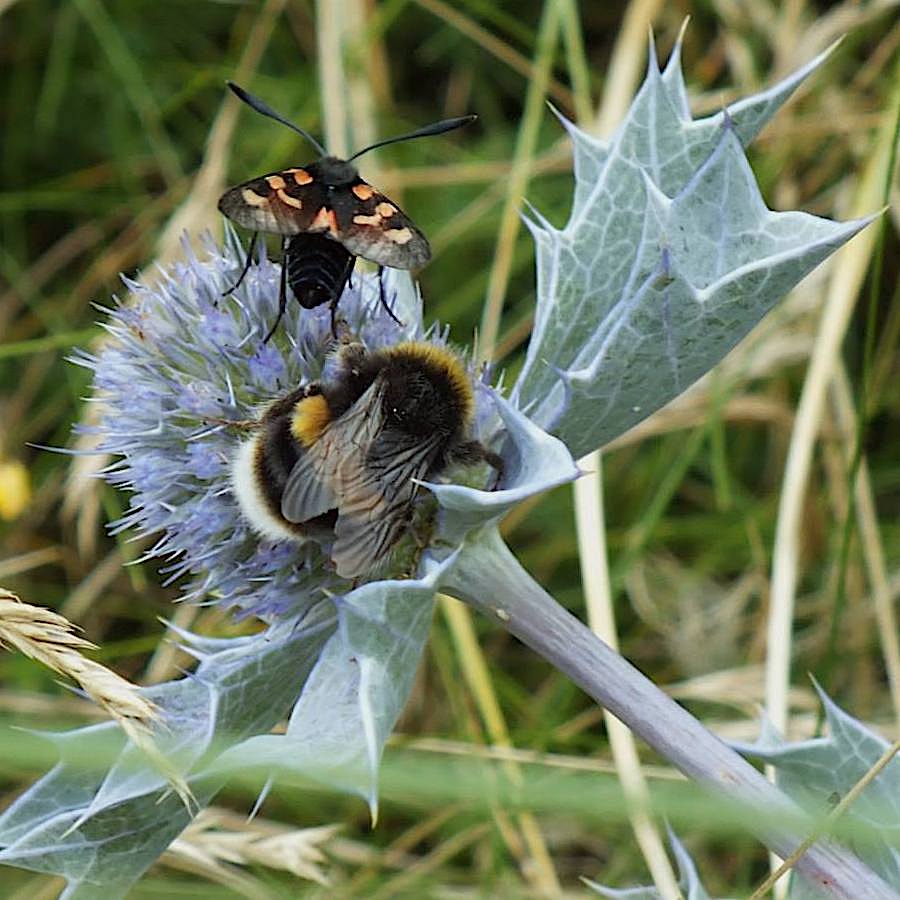
Insect pollinators love the spiky blue flowers of Sea-holly. Loe Bar is a wonderful place to spot this lovely plant.
Photo: Amanda Scott
Scientific name: Eryngium maritimum
What to look for:
- Flowers: Dense oval-shaped heads of bright blue flowers, somewhat like teasel flowerheads in shape.
- Leaves: Grey-blue, waxy, with spines and strongly veined. Leaves on stem are stalkless, while basal leaves have long stalks and are rounder in shape.
- Height: 30 to 60 cm.
- Where: Coast on beaches and dunes. Now largely absent from North and East Scotland and North-east England.
- When: The flowers appear from July to September.
- Habit: Upright.
- Similar to: Field Eryngo, an introduced, rare plant fund in southern England and the Channel Isles.
Sea-holly isn’t closely related to the green Holly of woodland and scrub. It is in fact a member of the Carrot family (the Umbellifers; Apiaceae), which includes plants such as Cow Parsley and Fennel. It’s easy, however, to see how Sea-holly gets its common name: the grey-blue leaves are spiky in shape and sport long spines.
That is where the similarities with true Holly end. Sea-holly is brilliantly adapted to its seaside home. The leaves are covered in a waxy cuticle, an adaptation to help conserve water in the plant’s salty habitat. The bright blue of the flowers contrasts beautifully with the pale grey of the leaves, but that pale leaf colour has a purpose: it reflects more sunlight than darker leaves, providing additional protection against excessive water evaporation from the leaf surface. Sea-holly roots stretch deeply beneath the surface in search of fresh water, providing a more secure anchorage in the shifting sand.

Invertebrates enjoy Sea-holly nectar in the late summer, and bees, butterflies, hoverflies and moths can be seen visiting the flowers. It is also one of the food plants of the Sand Dart moth caterpillars, which feed on sand-dune plants by day and burrow into the sand at night.
Did you know…?
…Flower on the Mersey: Sea-holly is Liverpool’s county flower
…Sea holly roots were once candied and eaten as a delicacy
More information and references:
Crafer, T., 2005. Foodplant List for the Caterpillars of Britain’s Butterflies and Larger Moths. Atropos Publishing, Holmfirth, UK.
Mabey, R., 1997. Flora Britannica. Chatto & Windus, London.
Rose, F. and O’Reilly, C., 2006. The Wild Flower Key, 2nd edition. Frederick Warne, London.
Stace, C., 2010. New Flora of the British Isles, 3rd edition. Cambridge University Press, Cambridge.
Published: August 2014
Author: Amanda Scott
Photos: Amanda Scott
